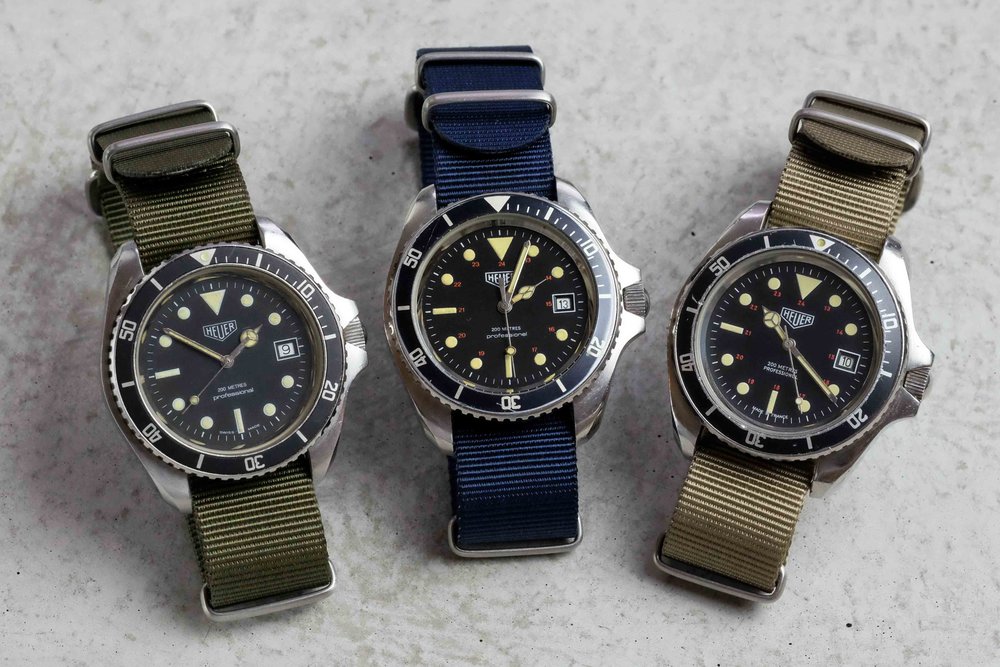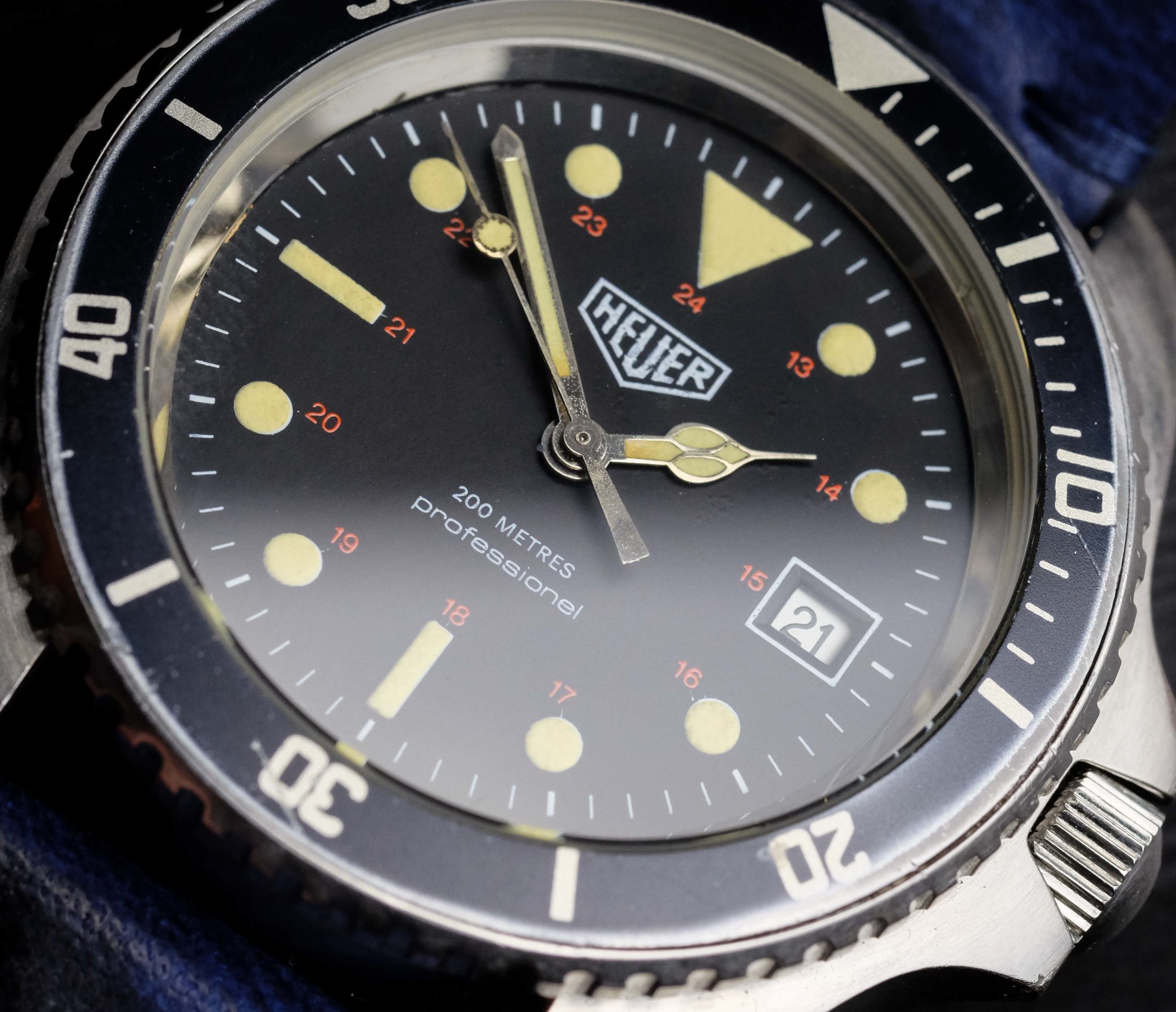Heuer Monnin 844: A Brief History and Collector's Guide

Heuer’s first dive watch — the Heuer Monnin Reference 844, has a special place in the rich history of Heuer. While Heuer did have a strong presence in the racing world, with famous Formula One drivers such as Mario Andretti and Jochen Rindt sporting the Heuer watches, the “quartz crisis” in the mid-70s led Heuer to be in financial difficulties. These emerging battery-powered watches had two major advantages compared to Heuer’s mechanical movements: they told time more accurately and they were cheaper. However, the emergence of the Monnin Reference 844 in 1979 brought unprecedented success, and is arguably the watch that saved the then-struggling Heuer.

Cathedral hands and 24-hour red Arabic numerals
The 844 emerged from numerous requests to Heuer during mid- to late-1970s for high quality private label watches for underwater sports with an affordable price. With this opportunity arising, Heuer decided to enter the diver watch market; with no previous experience of creating diver watches, as Heuer were far more accustomed to creating chronographs for timekeeping in racing. Cautious in their approach at the time, Heuer outsourced the production of their watches to a French company named Georges Monnin rather than investing new resources if they were to manufacture watches in-house in Switzerland.
Sales immediately took off once the 844 came out. So much so that Heuer decided to stop outsourcing the production of these watches and moved the production in-house to Switzerland.
The Heuer Monnin was first publicly marketed in the 1979 Heuer catalogue. The first two variants of the 844s are made in France. Production then moved to Switzerland for 844-2 through 844-5, with the 844-5 being the first to feature “TAG Heuer” on the dial. The 844 series were then succeeded by the 1000 series.

First (left) and second (right) iterations of the French-made Heuer Monnin 844
Dial and Hands
The first two variants of the 844, which was made in France, featured French writing “200 metres professionel” (note the French word “Professionel” instead of the English “Professional”) and 24-hour Arabic numerals in red. There are notable differences between the first two iterations: different fonts for the word “Professionel” and only the second iteration featured “Made in France” text below the 6pm hour marker. Both variants share a matte black dial featuring the date window at 3pm marker which resembles that of Rolex Submariner — launched two decades earlier in the early 50s.
The first release of the 844 came with a cathedral hour hand, a pencil minute hand and a wide base seconds hand with a circular lume. The second iteration of the French-made 844 came with a Submariner-inspired mercedes hour hand, pencil minute hand and a narrow base seconds hand where the lollipop is closer to the tip.
Variants 844-2 through 844-5, which were Swiss-Made, featured the writing “200 metres Professional” and “Swiss Made” (“T-Swiss Made-T” for the 844-2). The “Professional” font was reverted back to the one used in the first variant of the French-made 844. However, these Swiss-made variants no longer feature the red 24-hour markings on the dial.

Unsigned crown and beveled lugs

Unidirectional bezel with no lume pip

Caseback
Case and Bezel
All of the 844 variants share a 42mm stainless steel case which is much larger than the Submariner and the Omega Seamaster at that time. The case featured beveled lugs which should be visible on an unpolished case and prominent crown guards for its screw-in crown. The caseback of the original French-made 844 featured the writing “844” along with a four-digit serial number. Inside the caseback, it is signed “G. Monnin.”
The 844 features a unidirectional bezel with a 60 minute count-down. Only the first variant of the French-made 844 did not feature a lume pip on the bezel, with all other variants thereafter having this feature.

French-made automatic movement FE4611A
Image courtesy of Shucktheoyster
Movement
The French-made 844 were powered by FE 4611A where “G. Monnin” is signed on the rotor. These date complication automatic movements were also made by a French company, France Ebauches, which was the largest French manufacturer for ebauche movements at the time. On the other hand, the Swiss-Made 844 were powered by ETA 2872 with the exception of the 844-4 which featured a day-date complication movement.
Despite its deep roots in racing history, Heuer’s unexpected forays into the diver watch proved to be a success. The historical significance of the Heuer Monnin Reference 844 was not only in its role as a revenue driver for Heuer and how it may have potentially saved the company, but it also became the backbone of Heuer’s future diver watches.
Sources:
-
https://heuerville.wordpress.com/2011/10/17/heuer-844-monnin/
-
https://www.hodinkee.com/articles/heuer-diver-professional-deserves-more-credit
-
http://classicheuers.blogspot.com/2009/01/heuer-844-french-made-diver.html
-
https://mb.nawcc.org/threads/heuer-844-information-needed.59048/
-
https://forums.calibre11.com/threads/844-first-heuer-purchase-help-please.66976/
-
https://forums.watchuseek.com/f25/heuer-monnin-looks-little-off-2250977-2.html
-
https://forums.watchuseek.com/f25/heuer-844-monnin-auto-how-service-962888.html
-
https://forums.watchuseek.com/f29/fs-heuer-844-monnin-4626427.html
-
https://heuerville.wordpress.com/2011/09/06/heuer-diver-8443-automatic/
-
https://www.shucktheoyster.com/heuer-monnin-automatic-diver-ref-844/
4 comments
If you love exploring unique timepieces, Coveted has an incredible collection. The bold Hublot Big Bang Unico stands out for its innovative design. For diving enthusiasts, the Blancpain Fifty Fathoms Bathyscaphe is legendary. The elegant Omega Seamaster Aqua Terra is perfect for every day. And the classic Rolex Datejust 36 never goes out of style.
Thanks for rthe guide. It was really interesting. I have a question: i have a 844 monnin with same dial of 844 2 and same bezel but on the case back is written 844 1. I don’t see any info about a ref 844 1. The calibre is eta. Can you help me?
Very helpful overview on a rather mysterious sector of Heuer! One question regarding the statement below:
4611A where “G. Monnin” is signed on the rotor. These date complication automatic movements were also made by a French company, France Ebauches, which was the largest French manufacturer for ebauche movements at the time. On the other hand, the Swiss-Made 844 were powered by ETA 2872 with the exception of the 844-4 which featured a day-date complication movement
What movement is in the 844-4?



